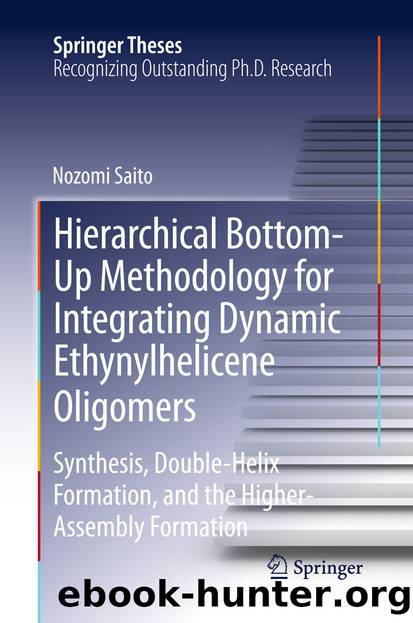Hierarchical Bottom-Up Methodology for Integrating Dynamic Ethynylhelicene Oligomers by Nozomi Saito

Author:Nozomi Saito
Language: eng
Format: epub
Publisher: Springer Japan, Tokyo
(M)-bD-4/(P)-bD-5
(M)-bD-4/(P)-D-5
(M)-D-4/(P)-D-5
(M)-D-5/(P)-DF-4
ε365/ε335
0.9
0.82
0.95
0.93
Morphology
Fiber/gel
Fiber/gel
Fiber/gel
Fiber/gel
Bundles
Large amount
Large amount
Small amount
Small amount
Thermal stability
Stable
Stable
Less stable
Stable
Transparency
Turbid
Turbid
Clear
Clear
MGC
1 mM
0.5 mM
0.1 mM
0.1 mM
5.2 Vesicle Formation in Diethyl Ether
Vesicular assembly was observed in diethyl ether, which was different from the fibers/gels in toluene. When solutions (diethyl ether, 1.0 × 10−4 M) were mixed in a 1:1 ratio, the mixtures of all the (M)-bD-4/(P)-bD-5, (M)-bD-4/(P)-D-5, (M)-D-4/(P)-D-5, and (M)-D-5/(P)-DF-4 systems immediately turned deep yellow and semitransparent. Tyndall scattering was observed by passing laser light (532 nm) through the solutions, which indicated the formation of small particles. Soft precipitates, and not gel, appeared and gradually increased in amount.
The CD and UV-Vis spectra of (M)-bD-4 and (P)-bD-5 (diethyl ether, 2.5 × 10−5M, 25 °C) were typical of a double helix and a random coil, respectively, and the calculated spectra showed relatively intense Cotton effects (Fig. 5.5a, top). The CD spectra of a 1:1 mixture of (M)-bD-4/(P)-bD-5 (diethyl ether, total 2.5 × 10−5 M, 25 °C) immediately showed an enhanced Cotton effects, which was different from the calculated spectrum. A steady state was reached after 3 h with a negative maximum at 315 nm and a positive maximum at 370 nm (Fig. 5.5a, top). The UV-Vis spectra also reached a steady state after 3 h, giving an ε 365/ε 335 of 0.78 (Fig. 5.5a, bottom).
Fig. 5.5CD (top) and UV-Vis (bottom) spectra (diethyl ether, total 2.5 × 10−5 M, 25 °C) of 1:1 mixtures of a (M)-bD-4/(P)-bD-5, b (M)-bD-4/(P)-D-5, c (M)-D-4/(P)-D-5, and d (M)-D-5/(P)-DF-4. Calculated spectra obtained by adding the spectra of the components (diethyl ether, 2.5 × 10−5 M, 25 °C) and dividing the total spectra by two are also shown
Download
This site does not store any files on its server. We only index and link to content provided by other sites. Please contact the content providers to delete copyright contents if any and email us, we'll remove relevant links or contents immediately.
| Automotive | Engineering |
| Transportation |
Whiskies Galore by Ian Buxton(41541)
Introduction to Aircraft Design (Cambridge Aerospace Series) by John P. Fielding(32893)
Small Unmanned Fixed-wing Aircraft Design by Andrew J. Keane Andras Sobester James P. Scanlan & András Sóbester & James P. Scanlan(32581)
Craft Beer for the Homebrewer by Michael Agnew(17938)
Turbulence by E. J. Noyes(7718)
The Complete Stick Figure Physics Tutorials by Allen Sarah(7151)
Kaplan MCAT General Chemistry Review by Kaplan(6606)
The Thirst by Nesbo Jo(6452)
Bad Blood by John Carreyrou(6286)
Modelling of Convective Heat and Mass Transfer in Rotating Flows by Igor V. Shevchuk(6232)
Learning SQL by Alan Beaulieu(6043)
Weapons of Math Destruction by Cathy O'Neil(5854)
Man-made Catastrophes and Risk Information Concealment by Dmitry Chernov & Didier Sornette(5673)
Digital Minimalism by Cal Newport;(5398)
Life 3.0: Being Human in the Age of Artificial Intelligence by Tegmark Max(5199)
iGen by Jean M. Twenge(5171)
Secrets of Antigravity Propulsion: Tesla, UFOs, and Classified Aerospace Technology by Ph.D. Paul A. Laviolette(5014)
Design of Trajectory Optimization Approach for Space Maneuver Vehicle Skip Entry Problems by Runqi Chai & Al Savvaris & Antonios Tsourdos & Senchun Chai(4849)
Electronic Devices & Circuits by Jacob Millman & Christos C. Halkias(4757)
